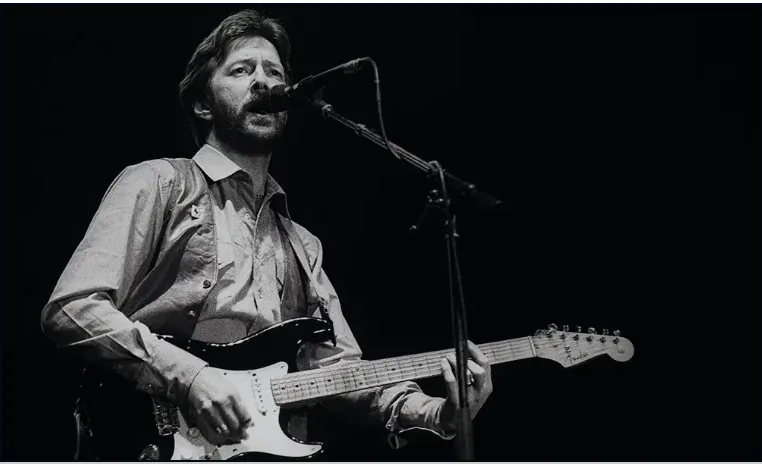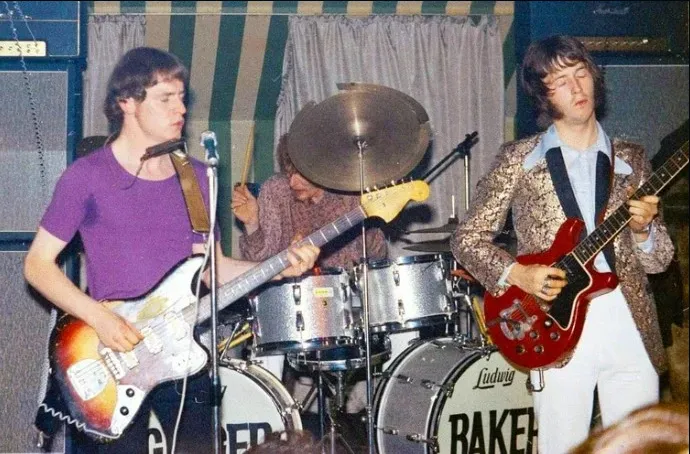In the pantheon of iconic guitars, few stand out as vividly as Eric Clapton’s SG, famously known as "The Fool."
More than just an instrument, this guitar symbolizes a transformative era in both Clapton’s career and the evolution of rock music.
So, what is it that makes Eric Clapton's SG so special? How did it earn its legendary nickname, and what stories do the swirling colors of "The Fool" hold? Let's dive into the fascinating tale behind this piece of musical history.
The Beginning: Eric Clapton and The Gibson SG

As the 1960s progressed, rock music was undergoing a metamorphosis, driven by innovative guitarists pushing the boundaries of sound and style. Eric Clapton was at the forefront of this revolution.
Known for his virtuosic skills, Clapton’s choice of guitar was always a point of intrigue among fans and fellow musicians.
During his tenure with Cream, Clapton adopted what would become one of his most famous instruments: a 1964 Gibson SG Standard.
The Gibson SG is a guitar celebrated for its sleek, devil-horned double-cutaway design and robust tonal versatility.
Clapton’s specific model came equipped with dual humbucker pickups, offering a range that could seamlessly transition from mellow blues to searing rock solos.
Birth of "The Fool"
Initially, Clapton’s SG was a standard sunburst model. However, its transformation into "The Fool" was born out of a desire to create something visually as striking as its sound.
In 1967, Clapton commissioned Dutch artists Simon Posthuma and Marijke Koger—members of the art collective known simply as "The Fool"—to embellish the guitar with an elaborate, psychedelic paint job.
The decision to have the guitar painted was not merely for aesthetics.
The late 1960s were a time of artistic revolution, and psychedelic art became synonymous with the countercultural movement sweeping through music, fashion, and social norms.
Clapton’s Gibson SG, adorned with the swirling, vibrant motifs characteristic of "The Fool" artists, became an emblem of this era of change.
The Design and What It Represented
"The Fool" guitar is nothing short of a visual masterpiece. Dominated by vivid, swirling colors, and symbolic imagery, every inch of the SG’s surface tells a story.
Immediately recognizable, the design features celestial and earthly elements that reflect a cosmic, utopian vision.
There's an array of bright colors and flowing patterns, interspersed with images of angels, clouds, and abstract shapes, representing an otherworldly essence that perfectly encapsulates the spirit of the psychedelic 1960s.
For Clapton, the guitar’s transformation symbolized a departure from tradition and an embrace of the boundary-pushing, experimental ethos that defined Cream's sound.
Tracks like “Sunshine of Your Love” and “White Room” became iconic not only for their musicality but also for the distinctive artistry of "The Fool" guitar that Clapton wielded onstage and in recordings.
Eric Clapton’s Fool Guitar: The Sound

Of course, the importance of Eric Clapton’s SG extended well beyond its stunning visual transformation. Its sonic qualities were equally vital to its legendary status.
The 1964 Gibson SG Standard was equipped with two humbucker pickups that provided Clapton with a wide range of tonal possibilities.
From the creamy, overdriven sound on “Crossroads” to the searing high notes on “Spoonful,” the guitar was versatile enough to handle Clapton's broad musical repertoire.
What set the SG apart in Clapton’s hands was the way it responded to his touch. Clapton’s playing style—fluid, yet intensely expressive—was perfectly complemented by the SG’s playability.
The guitar’s thin, fast neck allowed Clapton to execute his rapid-fire solos with ease, while the solid mahogany body delivered a sustain that became a crucial element of his sound.
Memorable Moments with Clapton’s Gibson SG
Eric Clapton’s Fool guitar was more than an instrument—it was a trusted companion throughout many pivotal moments in his career.
One of the most memorable appearances of the guitar was during Cream's "Farewell Concert" in 1968 at the Royal Albert Hall, a performance that has since become legendary.

Clapton’s mastery of the instrument, coupled with the guitar's iconic design, captivated audiences and left an enduring impression on the future of rock music.
Another unforgettable instance was the recording of "Disraeli Gears," where Clapton’s SG delivered some of the most enduring sounds of the psychedelic era.
The album's innovative approach, both sonically and visually, was mirrored in the swirling patterns and vivid colors of "The Fool" guitar.
Beyond the Stage
The impact of Eric Clapton’s Fool guitar extends far beyond its years in the spotlight with Cream.
The guitar has become an enduring symbol of a transformative period in rock history, influencing countless musicians and artists.
Its unique design has inspired numerous replicas and tributes, affirming its place as one of rock music’s most iconic instruments.
The guitar itself went through various hands after Clapton parted with it, each custodian adding to its storied history.
It was owned by the likes of Todd Rundgren, who utilized it extensively in his performances, thereby continuing its legacy in the world of rock.
Unique Characteristics and Technical Specifications
Eric Clapton’s SG, despite its awe-inspiring artwork, is also notable for its exceptional build and features.
The 1964 Gibson SG Standard is celebrated for its lightweight, double-cutaway design that facilitates higher-fret access—ideal for Clapton’s high-octane solos.
The combination of a mahogany body and neck, along with a rosewood fingerboard, generates a warm, resonant tone that’s unmistakable.
The SG’s dual PAF (Patent Applied For) humbucking pickups offer a wide tonal range, from creamy, bluesy tones to biting, aggressive screams.
This versatility made Clapton’s SG perfect for Cream's diverse repertoire, allowing for both crystalline cleans and saturated drives.
The Human Touch
For Eric Clapton, "The Fool" guitar was not just about its technical capabilities or its visual flair. It was about the stories it helped tell and the emotions it could convey.
Clapton’s hands on the fretboard, feeling the wood and strings, transferring his inner tumult into sounds that would echo across generations, transformed the guitar into a living, breathing entity.
This human connection, this transference of energy and emotion, is what turns an ordinary instrument into a legend.
Many who’ve had the privilege to strum its strings or even see it up close speak of a palpable sense of history and artistry that surrounds "The Fool."
Eric Clapton's Fool Guitar: A Lasting Impression

In the grand tapestry of rock and roll history, Eric Clapton’s Fool guitar occupies a place of grandeur.
From its early days as a standard Gibson SG to its glorious transformation at the hands of visionary artists, and its accompaniment to Clapton’s iconic performances, the guitar is more than just wood and strings.
It’s a piece of living history, a testament to a time of incredible creativity and change.
As "The Fool" continues to inspire and captivate, it reminds us of the artistry that goes into not just playing music but also crafting the instruments that make such music possible.
Clapton’s SG is an emblem of innovation, serving as a touchstone for new generations of musicians who look to its colorful past with an eye towards future possibilities.
Eric Clapton’s Fool guitar is not merely an instrument; it’s a narrative, a piece of rock mythology, and a profound symbol of artistic freedom.
From its inception as a 1964 Gibson SG to its transformation into a psychedelic masterpiece by The Fool, this guitar has been a witness to some of rock music’s most pivotal moments.
It has churned out riffs and solos that have become etched in the annals of music history. Today, "The Fool" remains a beacon of creativity, a symbol of a golden era of music, and a piece of living art that continues to inspire.
For the Jervis Family, recounting the legendary tales of such an iconic instrument is not just a tribute to Eric Clapton but a celebration of the timeless bond between musician and guitar.
And as long as there are strings to be played, this legendary SG will forever be a touchstone in the world of rock and roll.



